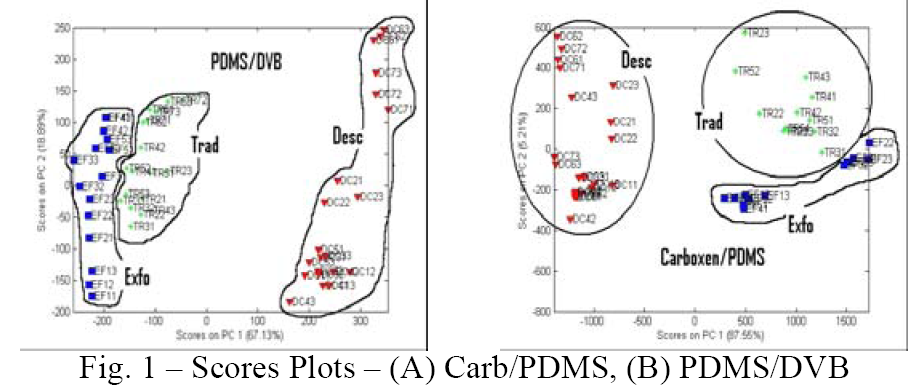volatile and non-volatile chemicals present in different concentrations. Most of those compounds are
formed during the roasting process of the green coffee beans1, especially by the so-called Maillard
reactions. Due to the obvious importance of flavor on consumer acceptance and quality perception, the
coffee’s chemical composition has been intensively studied2. However, due to its complex nature, the
association of the quality of roasted coffee to its volatile composition demands the use of chemometrics
methods for data treatment. In the present work, we demonstrate that Principal Component Analysis
(PCA) allied to gas chromatographic data, obtained after isolation and pre-concentraction of the volatile
fraction of roasted coffee by using Solid Phase Microextraction (SPME), could be an alternative for
chemical classification of coffee samples.
Samples and experimental conditions: Triplicates of eighteen different Brazilian commercial coffees
were analyzed (seven of them were medium roasted and decaffeinated; other six had normal roasting and
the other five were extra roasted – all of them from different production batches). The extraction and
chromatographic conditions were optimized according to the literature. Two fibers, SPME coated with
Carboxen/PDMS and PDMS/DVB were employed. Therefore, two data sets were obtained ([54 x 7501]
and [54 x 5100]). Data processing was carried out with Matlab 6.5 software. The raw chomatograms for
both SPME fibers were aligned using COW (correlation optimized warping)3. The data was meancentered
and variable selection was performed for better discrimination.

The selected regions were: PDMS/DBV- 1486-1822, 2237-2443, 2798-3004 and 3350-4040 (X = [54
x 1442]), Carb/PDMS – 1548-2020, 2190-2480 and 3313-3800 (X = [54 x 1252]). PCA was applied and
revealed clusters according to the coffee roasting process. In the PC1xPC2 score plot (Figure 1), three
groups of coffees could be clearly distinguished as follows: The decaffeinated coffee (Desc) samples
formed one separated cluster, probably not only due to roasting but also to the caffeine extraction
process. The other two groups have a higher similarity degree and correspond to different roasting
processes – Traditional (Trad) and extra roasted (Exfo). The exploratory data analysis clearly shows the
potential of SPME-GC-FID coupled to chemometrics to differentiate commercial roasted coffees.
According to the results, any of the two SPME fibers could be used separately simultaneously to
discriminate the roasted coffees by their flavor compounds.